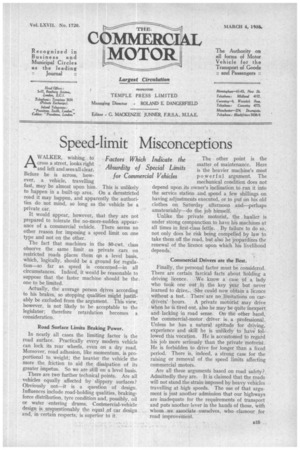Speed-limit Misconceptions
Page 25

If you've noticed an error in this article please click here to report it so we can fix it.
Factors Which Indicate the Absurdity of Special Limits for Commercial Vehicles
AWALKER, wishing to cross a street, looks right and left and sees all clear. Before he is across, however, a vehicle, travelling fast, may be almost upon him. This is unlikely to happen in a built-up area. On a derestricted road it may happen, and apparently the authorities do not mind, so long as the vehicle be a private car.
It would appear, however, that they are not prepared to tolerate the no-more-sudden appearance of a commercial vehicle. There seems no other reason for imposing a speed limit on one type and not on the other.
The fact that machines in the 50-cwt. class observe the same limit as private cars on restricted roads places them op a level basis, which, logically, should be a ground for regulation—so far as speed is concerned—in all circumstances. Indeed, it would be reasonable to suppose that the faster machine should be the. one to be limited.
Actually, the average person drives according to his brakes, so stopping qualities might justifiably be excluded from the argument. This view, however, is not likely to be acceptable to the legislator; therefore retardation becomes a consideration.
Road Surface Limits Braking Power.
In nearly all cases the limiting factor is the road surface. Practically every modern vehicle can lock its rear wheels, even on a dry road. Moreover, road adhesion, like momentum, is proportional to weight; the heavier the vehicle the more the friction to aid the dissipation of its greater impetus. So we are still on a level basis.
There are two further technical points. Are all vehicles equally affected by slippery surfaces? Obviously not—it is a question of design. Influences include road-holding qualities, brakingforce distribution, tyre condition and, possibly, oil or water entering drums. Commercial-vehicle design is unquestionably the equal of car design and, in-certain respects, is superior to it. The other point is the matter of maintenance. Here is the heavier machine's most powerful argument. The mechanical condition does not depend upon its owner's inclination to run it into the service station and. spend a few shillings on having adjustments executed, or to put on his old clothes on Saturday afternoon and—perhaps amateurishly—do the job himself.
Unlike the private motorist,, the haulier is under strong compunction to have his machines at all times in first-class fettle. By failure to do so, not only does he risk being compelled by law to take them off the road, but also he jeopardizes the renewal of the licence upon which his livelihood depends: Commercial Drivers are the Best.
Finally, the personal factor must be considered. There are certain farcical facts about holding a driving licence. We know a case of a lady who took one out in the key year but never learned to drive._ She could now obtain 'a licence without a test. There are no limitations on car drivers' hours. A private motorist' may drive When he is tired out, also he may be quite inexpert and lacking in road sense. On the -other hand, the commercial-motor driver, is, a professional. Unless he has a natural aptitude for driving, experience and skill he is unlikely to haVe" followed this vocation. He is accustomed to regard his job more seriously than the private motorist. He is forbidden to drive for longer than a fixed period. There is, indeed, a strong case for the raising or removal of the speed limits affecting commercial motors.
Are all these arguments based on road safety? Admittedly they are. It is claimed that the roads will not stand the strain imposed by heavy vehicles travelling at high speeds. The use of that argument is just another admission that our highways are inadequate for the requirements of transport and puts another lever in the hands of those, with whom -.we associate ourselves, who clamour for road improveinerit.




















































































